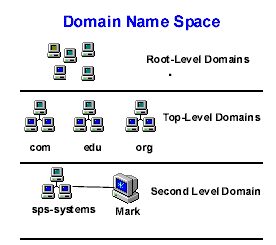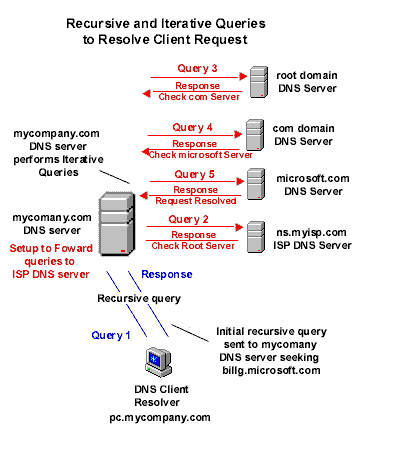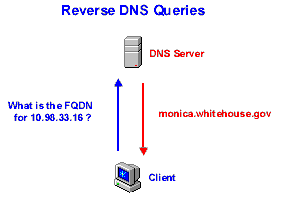|
|
|
Domain Name Resolution

 |
|
Domain Names
FQDN = Host name + Domain Name
FQDN = NTSRV + MYCOMPANY.COM = NTSRV.MYCOMPANY.COM
The domain name can any combination of letters A to Z, digits 0 to 9 and the hyphen (-), the period (.) is used as a separator. Domain names are not case sensitive. When naming hosts on your Windows Network that will act as Internet hosts it best to use characters that comply with Netbios and FQDN names avoid the Underscore (_).
Recursive, Iterative and Reverse Queries
Recursion - When a DNS server perform a recursive query on the client's behalf the DNS server stays with the query until the request has been resolved.
Query 1
In the Diagram below the client at pc.mycompany.com makes a request to the corporate DNS server. The DNS checks it's cache to see if the query has already been resolved and in the cache. In this query the corporate DNS server has no record of this query. The corporate DNS switches roles and now acts as client to issue a iterative query to the local ISP.
Iterative- queries enable DNS servers to pass back pointers or referrals. When a client issues a iterative query to a DNS server, the DNS server may not have the answer but may refer the client where the answer can be obtained.
Query 2
The corporate DNS sever is set up to forward requests to the ISP DNS name server. The ISP name server has no record of this resolved request. The ISP server replies back with a hint to query the root domain server.
Query 3-5
The DNS server issues an iterative query at the top of the DNS hierarchy to the root level server. After each query and response the server goes down the DNS tree to it finally finds the correct resolved name.
Response
The corporate DNS server returns the response to the client, completing the recursive query.

Reverse Queries
In a reverse query the client issues a IP address and queries the DNS server for a fully qualified domain name (FQDN).
